Welcome to our Colossus Movie Guide for Looper. This guide contains everything you need to understand the film. Dive into our detailed library of content, covering key aspects of the movie. We encourage your comments to help us create the best possible guide. Thank you!
What is Looper about?
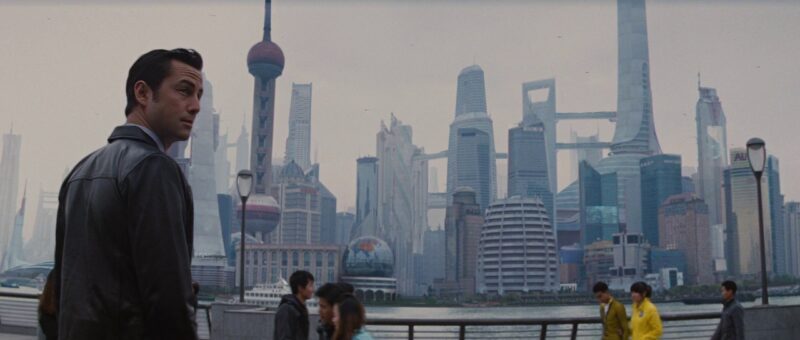
Looper is all about how we utilize our time. The very title of the film (Joe’s very job title, to boot) suggests that time exists in a loop, that our paths in life are predestined. But the time travel logic of the film deems that is not true. New decisions can be made and alter the course of any given timeline. Then decisions made in that altered timeline can affect the succeeding timeline—and so on. Which means our fates are not predestined, but that time functions as a result of free will. We can alter the course of time based on the relationships we foster and the morals we carry.
Thus, Looper becomes a defamiliarization of how our decisions have consequences, how our choices cause a ripple effect in time. The looper system seeks to establish consistency so that it will always have the ability to dispose of bodies in a future where it’s difficult to commit murder. But as we see, time doesn’t exist cleanly as a loop, and instead is constantly subject to cause and effect. And somewhere during those loops, Cid loses someone dear to him and becomes a criminal overlord—thus, violence begets violence. This causes a loop of violence that these assassins become desperate to break free from in the future. Bad people and poor morals create a continuously bleak future.
That is until Joe is able to recognize this loop of violence and put an end to it. He chooses a path of light in a world that cyclically kept Cid in a world of darkness. Joe’s enlightened path causes the looper system to end and opens up the possibility for a fellow abandoned child to gain the bright future he never had. The entire movie is Joe’s path towards this realization—away from selfishness and towards selflessness.
Movie Guide table of contents
Cast
- Joseph Gordon-Levitt – Young Joe
- Bruce Willis – Old Joe
- Emily Blunt – Sara
- Pierce Gagnon – Cid
- Jeff Daniels – Abe
- Noah Segan – Kid Blue
- Paul Dano – Seth
- Frank Brennan – Old Seth
- Piper Perabo – Suzie
- Summer Qing – Joe’s Wife
- Tracie Thoms – Beatrix
- Garret Dillahunt – Jesse
- Nick Gomez – Dale
- Rian Johnson – Writer and director
The ending of Looper explained
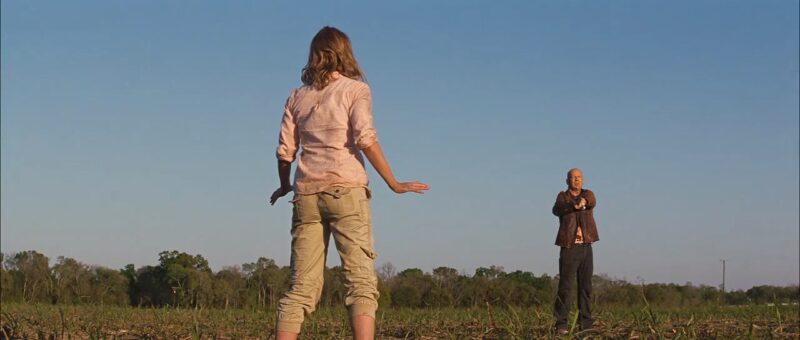
There are two facets of this ending explanation: the time travel explanation and the thematic explanation. Understanding the time travel logic will better help us to understand the thematic depth, so let’s start with that first.
Despite the movie being called Looper, the time travel laws of the film don’t function as a loop, but instead operate on a causality principle. This means changes made in the past have immediate effects on the future. This is evident throughout the movie. Let’s review a few instances:
- Physical changes: When a younger version of a character is hurt, the older version instantly bears the scars or injuries. A prime example is when Seth’s younger self is mutilated, causing the older Seth to lose his limbs and facial features in real-time.
- Existence erasure: As demonstrated by the ending, if the younger self dies, the older version ceases to exist. This is because the future from which they came is rewritten, and they never get to live to that older age.
- Memory and experience: The older loopers retain memories of their past (which is the present for their younger versions). However, these memories can become hazy or change if the younger version has different experiences. Old Joe’s memories start to shift based on Young Joe’s actions.
- Closed loops: The criminal syndicates use time travel to send targets back in time for execution because it’s nearly impossible to dispose of bodies in their future. However, this creates a loop that they eventually close by sending the older looper back in time to be killed by their younger self.
While Looper lays out these rules of time travel, it doesn’t delve too deeply into the complexities or paradoxes. Director Rian Johnson intended for the focus to be on the characters and narrative rather than the intricacies of time travel mechanics. He was much more concerned with the time travel aiding the thematic meat of the film than the other way around. Thus, the time travel logic serves to emphasize the film’s themes of confronting yourself stopping cyclical violence.
At the end of the film, Joe realizes why Cid becomes the Rainmaker in the first place—because of people like him. Because of loopers, who are essentially bad men. They kill for a living and care about nothing but collecting money. They own piles of silver, and even eventually earn some gold…by taking their own life. That’s right: they’re so greedy and motivated by money that they’ll take their own lives without question. This behavior breeds the kind of man Joe will become: a wild, ravenous gangster that takes and kills with reckless abandon. The lifestyle brews insane levels of selfishness.
This causes Joe to realize that time isn’t in a “loop” as he had always envisioned. In a past timeline, Old Joe was killed and Young Joe went on to live his life. But in this timeline, Old Joe escapes. But in both timelines, Cid experiences debilitating trauma. In the previous timeline, Cid still became a monster. He clearly had a vendetta against the loopers, so we can only assume that a looper in another timeline shot Sara as she protected Cid—exactly as older Joe was about to do just before younger Joe takes his own life.
This is why Young Joe shoots himself. In that moment, he had to confront himself and everything he’d become if he allowed the cycle of violence to continue to ruin Cid’s life. He realizes that time isn’t a loop, but instead the result of our actions. We don’t just define timelines for ourselves, but for everybody else with our actions. Old Joe’s vengeful actions would have continued the cycle of violence. But Young Joe’s selfless sacrifice causes that loop to stop. And because of it, Sara can now work with Cid to control his anger, to use his powers for good.
The themes and meaning of Looper
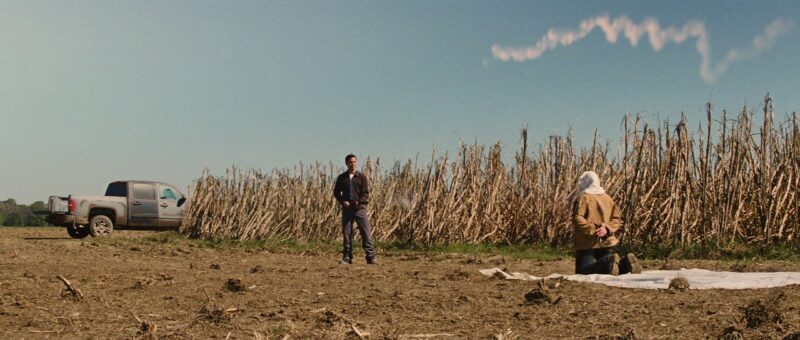
The difficulty in confronting yourself
In the literal plot of the movie, Young Joe must face off against his older self from the future. But in a broader symbolic sense, this can be seen as a universal struggle we all face: confronting ourselves. Our decisions have consequences and take us down roads that define who we are and where we’ll go and how people will look at us and remember us. And Young Joe’s future is pretty ugly, as Old Joe was a selfish, greedy monster who stole and killed until a woman changed his outlook. When Old Joe travels back from the future, Young Joe is faced with a fear that we all can recognize: that we might someday become the worst version of ourselves. Or that we won’t go anywhere near the best version of ourselves.
The meeting between Young Joe and Old Joe at the diner isn’t just a narrative device—it’s an artistic representation of the internal dialogue many people experience when reflecting on their past. We often look back on our younger selves with a mix of nostalgia, regret, and sometimes admonishment for the choices made. This dynamic becomes even more complicated when we project forward, anticipating the possible regrets of our future selves.
Essentially, Old Joe is a manifestation of inner conflict—it’s the embodiment of the battle between past mistakes and the quest for redemption in the future. Young Joe is already wary of his path. He kills for a living; he sells out his best friend, Seth, for some silver stashed in his apartment; he tries to play Robin Hood with Suzie, but not even she wants to go near his blood money. All in all, there’s not much to be proud of. These are the ingredients of a man who will someday kill innocent children out of selfishness. And this reality forces Young Joe to recognize his current path in life and correct it.
Disrupting the cycle of violence
We see the cycle of perpetual violence play out in several characters in Looper, but especially through Joe and Cid. As the protagonist of this time travel movie, Joe makes presents an internalized facet of this theme. By killing targets from the future, Joe perpetuates a system where his eventual fate—being sent back for his younger self to kill—is sealed. This self-sustaining cycle raises questions about predestination and free will. Can individuals ever break free from such vicious cycles, or are they eternally trapped by their choices?
Through Cid, however, it’s an externalization of the theme, akin to what we see through Jack’s son Danny in The Shining. The Overlook Hotel has a wrought history with violence, which included the murder of two young girls. The hotel then overtakes Jack and forces him to channel his violent energy towards his family. Danny’s psychic abilities enable him to anticipate the threat posed by Jack (and the hotel) and navigate through trouble. By surviving the physical violence enacted upon his family and mentally overcoming through the hotel’s violent past, Danny symbolically reconciles with the history and breaks free from its chain of repetition.
We see a similar journey for Cid in Looper through the battle between Young Joe vs. Old Joe. Old Joe believes that by traveling back in time and killing Cid, he’ll be able to change the course of time and improve his future. But all Joe is doing is perpetuating a continuous loop: he would kill Sara and send Cid straight back into the timeline where he’s hellbent on murdering all the loopers and using his telekinetic powers for evil. Old Joe thinks he’s stopping it, but all he’s really doing is spreading more ugliness.
Young Joe is able to recognize this cycle of violence and put an end to it (this is discussed further in the ending explanation). From the dirt of selfishness and ugliness rises beauty and compassion. Unlike Old Joe, who wishes to destroy, Sara seeks to be kind and patient with Cid, to guide him towards a life where he can use his telekinetic powers for good. The only reason Cid goes down a dark path is because of people like Old Joe who bolster violence. But Young Joe’s decision to take his own life shows that disrupting the cycle requires radical, sacrificial action. It pushes us to consider what lengths we might go to paint a better future for both ourselves and mankind.
Why is the movie called Looper?
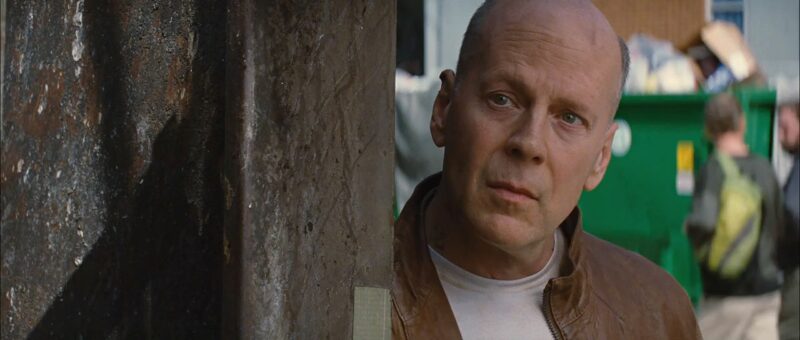
The title Looper carries an abundance of meaning. On a literal level, the title of the film is simply Joe’s job title—but that alone takes us down a few roads. The fundamental aspect of a looper’s job is the eventual “closing of the loop.” This means that a looper is contracted to eventually kill their older self, sent back from the future. This ensures that there are no loose ends left that could implicate the crime syndicates. This cycle of Young Joe executing Old Joe is quite literally a loop, calling attention to the cyclical nature of his employment.
This implies that time exists in a loop…yet, we see that is not the case. Which brings tension to the title of the film. Ostensibly, Joe is forever caught in a loop where he must kill himself. But we see when Old Joe escapes Young Joe that time can be altered—it’s not a loop at all. This completely complicates the movie’s examination time, fate, and destiny. What is predestination? And what is free will? We can often feel like we’re caught in a “loop,” that we have no control over our fates and where we’re heading. But…is that true? As we see from Young Joe’s sacrificial action at the end of the movie: it is not.
The true “loop” of the movie actually doesn’t have anything to do with Joe—it has to do with Cid. Because of the looper system, Cid becomes the evil “Rainmaker” and wreaks havoc on the world. We don’t know what happens to him to cause him to become this way, but we know the loopers had something to do with it. Perhaps like somebody killed Sara like Old Joe was about to do. And because of that, Cid uses his telekinetic powers for violence. The choices made by people like Joe—especially the violent ones—come back around in a cycle. And because of it, Cid is caught in a loop where the loopers push him to become a hellish version of himself.
That is until Young Joe decides to close the loop. Before Joe meets Cid, “closing your loop” simply means killing your future self. But in order to save Cid and Sara, Joe realizes he must cease the endless loop of violence that has pushed Cid to radical levels. This gives the title of the movie an ironic twist. You can indeed break out of a loop, as long as you’re able to reflect upon yourself and see the diverging paths of your decision. If you opt for compassion, for kindness, if you’re capable of sacrificing yourself for the good of others, then you’ll help build a better world. Young Joe recognizes Old Joe’s selfish plight and decides to change it—and close the loop.
Important motifs in Looper
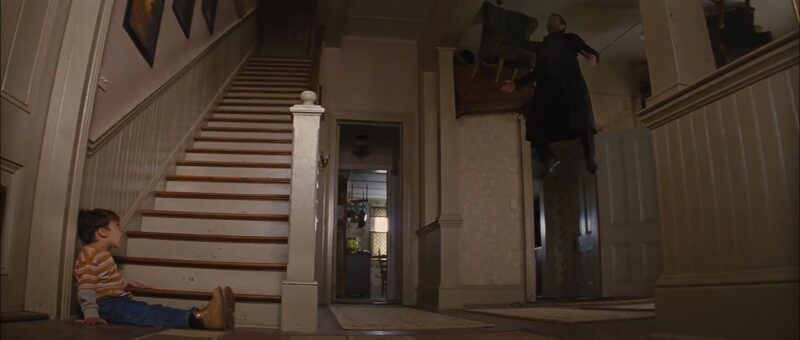
Abandoned children
The motif of abandoned or lost children is central to Looper, and specifically connects Young Joe with Cid. Joe was abandoned by his mom as a child, which shapes his motivations and decision making. Cid’s potential future as the Rainmaker is also tied to the trauma he might experience if Sara were to be murdered. These narratives emphasize how neglect and abandonment in childhood can lead to destructive futures, highlighting the importance of nurture and care. Old Joe is vengeful and wishes to rip the child’s future apart in order to save his own. But Sara shows the potential for growth and a better future for all mankind if you offer patience and compassion.
Clocks and time
Given the film’s central premise of time travel, clocks and the visual representation of time are recurring motifs. Scenes are often punctuated with ticking clocks, watch faces, and other indicators of time. They serve as constant reminders of the looming future, the inevitability of the loops being closed, and the relentless march of time that the characters are fighting against. This is important as the movie establishes its time travel logic. Time doesn’t function as a “loop” despite the movie’s title, but instead as a cause-and-effect structure. The tick-tick-ticking of the clock then gains gravity and tension, as time is revealed to be more of a free will situation than a predestined one.
Silver and gold
Payment to a looper is made in the form of silver bars, while the final payout, when one’s loop is closed, is paid in gold. These metals not only symbolize the transactional nature of the loopers’ existence but also contrast the value of the present (silver) against the future (gold). This motif underscores Joe’s struggle between immediate gratification and long-term consequences—which, tangentially, plays into his struggle between caring only for himself and caring for others. Old Joe exemplifies a future where he cares more about fixing his present situation at the cost of something much greater in the future. But by choosing to forgo the golden future and take his own life, Young Joe is able to transcend placing a monetary value on himself and others. He grows as an emotionally intelligent human being.
Fields vs. the city
The dichotomy between the open fields of the farm and the chaotic urban environment of Kansas City serves as a visual motif representing two contrasting futures. Sara’s farmhouse, surrounded by vast fields, symbolizes hope, growth, and a chance for a better future—especially for Cid. The city, on the other hand, is a representation of decay, corruption, and a cyclic trap, reflected in Joe’s life as a looper and the young vagabond children. This is why Joe struggles in the city, but finds clarity and catharsis out in the open air.
Questions & answers about Looper

Who is the Rainmaker? And why is he closing all the loops?
The Rainmaker is a ruthless man from the future who rises to immense power in a short period of time and takes control of the major cities and the criminal underworld. Some of the only details we learn about the Rainmaker is that he has a synthetic jaw and became vengeful after seeing his mother killed in front of him as a child.
It’s later revealed that Cid, who has a unique and dangerous telekinetic ability, is the potential future Rainmaker. When he loses his temper, especially when he or Sara feels threatened, his powers manifest in violent and uncontrollable ways. This raw, immense telekinesis, combined with the trauma of potentially witnessing Sara’s death, is what could lead him to become the Rainmaker.
This information tells us why the Rainmaker might be closing all the loops. Firstly, as a crime boss looking to control the crime syndicate, closing the loops allows him to eliminate potential threats and reshape the criminal underworld in his vision. Second, given that loopers (like Joe) possibly destroyed his life, he might be driven by a personal vendetta.
How many different timelines are there?
As I mentioned in the ending explanation, it’s difficult to provide a concrete answer when Rian Johnson admittedly provided minimal logic about the time travel rules. But based on what we see and hear, I feel confident saying there’s just one timeline that is continually affected. Ostensibly, that signifies that time is a loop. But as we discussed in the title section, that’s not true. Timelines can change, which makes it more of cause-and-effect situation. So while timelines can repeat like they would in a loop scenario, that loop is always changing based on whatever new actions occur—which means the loop can end. As we see at the end of the movie.
For sure, we know at least three timelines exist—but there could. be many, many more timelines. We never know for sure. Let me explain:
The first timeline would be the time that existed before time travel was invented. Then Abe came back to start up the looper program, which is presumably when Joe would have been hired. This is the “second” timeline, but this timeline could have been repeated many times. In this timeline, Young Joe kills himself and becomes Old Joe. We see that happens once, but this could have happened many times. And we know that eventually, Old Joe is able to escape Young Joe and seek out the Rainmaker.
The “escape” is why the second timeline could have repeated many times. As we answered in the previous question, the Rainmaker ostensibly has a vendetta against the loopers because one of them killed his mother, Sara. And as we’ve discussed regarding the time travel logic, these “loops” can change based on what people do within a given timeline. That means at some point in one of these timelines, one of the loopers managed to escape and bring misery to Cid’s life, presumably by killing either Sara or her sister, who cared for Cid for several years. This triggered a cycle of misery for Cid that caused him to become the Rainmaker. This then forced a continuous loop of violence and revenge (one of the major themes in the film) where loopers constantly escape their younger selves and push Cid into a downward spiral—this could have happened just once, or many times.
Why didn’t they just kill Young Seth?
One major question people have about the torture of Young Seth is…why did it have to happen? The gat men removed Young Seth’s body parts to draw out Old Seth. But why not just kill Young Seth instead? Wouldn’t that just rid them of future Seth? There’s no real answer or logic provided for this one. The only attempt is Abe saying that it’s “too dangerous” to do that—but nothing else is offered to the audience.
But it’s not too hard to discern what could be “dangerous” about this situation. The looper system has every incentive to make sure the loopers remain alive for the full thirty years so the looper system can remain intact as is. This ensures fluidity and consistency, that there will always be an older self to send back to the younger self. Killing the younger version of Seth would mean there would never be an older Seth and would alter all of history—including the mob’s system in the future. So it’s just cleaner to kill the older Seth.
It would be nice to receive some more details, however. If this is the case, then what if Seth dies during those thirty years? Are they protected by the looper system to ensure this doesn’t happen? Or perhaps Young Seth is killed after they murder Old Seth? And they simply replace him in a new timeline? There’s a lot of maybes in this situation, but no clear-cut answers.
Why didn’t they just kill Old Joe in the future?
Another qualm people have with the movie: why not just killed the older versions of loopers and send them back in time to be disposed of? The movie actually provides an answer for this. As it’s explained, everyone in the future is tracked so authorities know when they die. This is what makes time travel useful, as instead of murdering in the present and alerting authorities, you can send people back to the past to be murdered instead. This way, the authorities can’t examine a dead body and trace it back to the murderer.
Now it’s your turn
Have more unanswered questions about Looper? Are there themes or motifs we missed? Is there more to explain about the ending? Please post your questions and thoughts in the comments section! We’ll do our best to address every one of them. If we like what you have to say, you could become part of our movie guide!

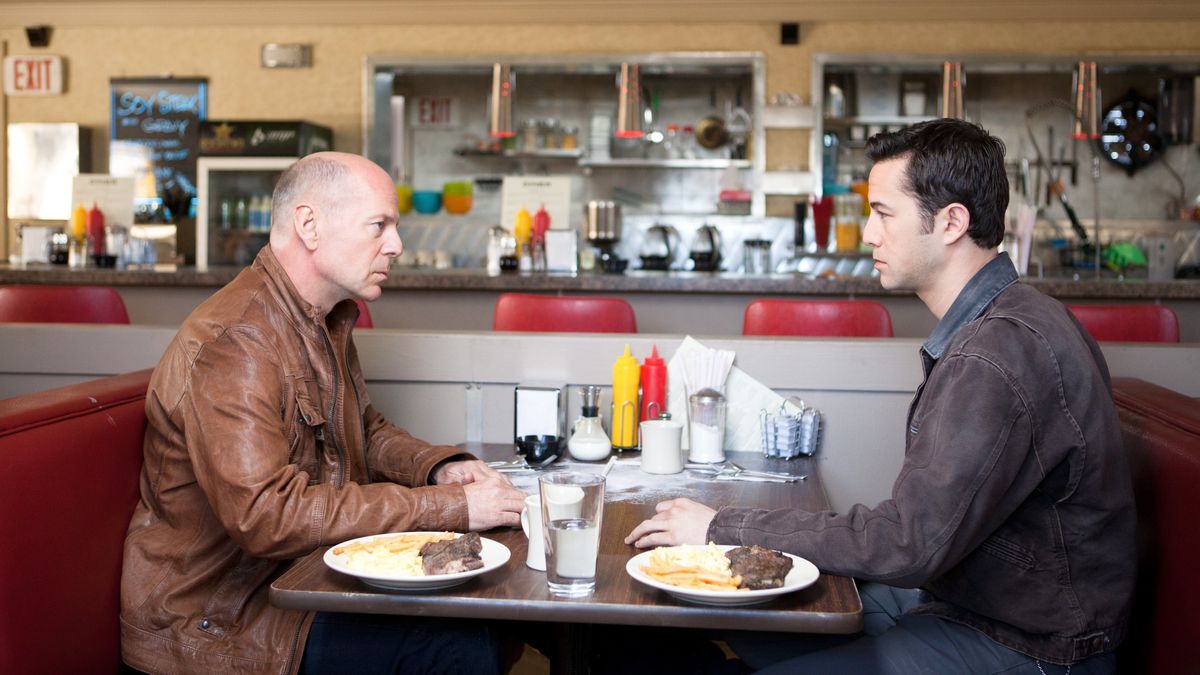
Not a question specific to looper, but Chris or Travis have either of you watched the German time-travel Netflix series Dark? It ratchets up the time travel complexity to 100 and has some of the tightest writing and plot I’ve seen in a show/film. Would be interested in your thoughts if you have seen it, or a recommendation to try it if you haven’t!